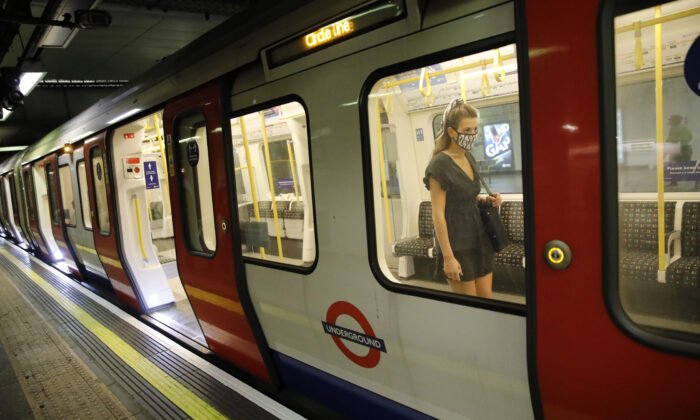Study Reveals Alarming Air Quality Levels Deemed “Very Unhealthy” on London Tube Network
An experiment conducted by The Epoch Times showed plausible evidence air quality on the London tube network could venture into dangerous levels, according to the Air Quality Index (AQI).
The Epoch Times conducted an experiment using a handheld Temtop Air Quality Detector on Aug. 29. The results were consistent and appeared to maintain their accuracy at all times.
Making the journey alongside motoring journalist and content creator, Shahzad Sheikh, better known by his Youtube channel name, BrownCarGuy, a route was pursued across several underground lines, assessing air quality readings.
The Air Quality Index (AQI) gauges how clean or polluted the air is in a specific area. It considers key pollutants like particulate matter and dangerous gases.
The AQI scale ranges from 0 to 500. Lower values (0–50) indicate good air quality, while higher values (151–500) often mean hazardous conditions.
Starting the journey at street level in London’s busiest shopping street, Oxford Circus, overground air quality appeared good. It averaged between 6 and 9 on the AQI all the way along the portion of the street from Bond Street station, with a maximum reading of 11, taken adjacent to the exhaust of a lorry.
AQI parameters rate the first 50 spaces on its index as good before the air quality turns to moderate. Anything over 100 is immediately categorised as “Unhealthy for Sensitive Groups.”
Over 150 is categorised as unhealthy for all, while a reading of over 200 is categorised as “Very Unhealthy.” Typically the highest hazardous rung is reached once 300 is surpassed on the scale.
Very Unhealthy Readings
Once entering the station, a gentle spike to 25 started, until moving past an air vent prior to reaching the platform. Here, a more aggressive spike of 176 was reached as air from a passing train began to billow out.
On the platform of the Central Line below, a reading of 230 on the AQI was recorded as a train entered the platform.
It registered 226 in Tottenham Court Road, on the platform of the Northern Line, as a wind was felt from a train pulling into a different platform from where the reading was taken.
When a train eventually arrived on the platform where the device was held, another reading of 230 was recorded.
Mr. Sheikh suggested that the trains may be acting like a flue cleaner, pushing dirty air ahead of the train into the station, into the breathing space of waiting passengers.
He claimed that the highest reading he had seen during his own research was well over 250 AQI.
Trade Union Silence
He also posed the question to ask why no trade unions appear to be pushing for worker’s rights for those who appear to work at times in potentially semi-hazardous air quality on TfL routes.
Continuing the journey across several different lines, regular readings were seen of over 150, while on segments closer to the ground (such as on the District Line between Sloane Square and South Kensington), readings registered around the 75 mark, often dropping at overground stations back to normal levels.
Alan Miller, founder of the Together Declaration, a cross-party pressure group, told The Epoch Times in an interview that the issue of air quality on the underground was “something that definitely needs proper scrutiny.”
Mr. Miller said: “Our air quality above ground is really good. In international metrics we performed very well. [In the] past four decades, it’s improved, beyond all recognition.
“And yet underground with TfL, where the mayor is responsible for that, there seems to be a complete silence about the particles and the [health] impacts.”
He claimed that the mayor was “spinning yarn” regarding claims that pollution overground in the city was leading to ‘thousands’ of deaths, adding, “None of the evidence shows that even CFOs own study shows it’s of negligible impact.”
‘Not Acceptable’
Mr. Miller suggested that greater emphasis should be placed on looking into air quality in the Tube network, while slating the amount of funding being put into expanding London’s Ultra Low Emissions Zone (ULEZ).
He added that people would simply find it “not acceptable.”
Responding to an anonymous freedom of information request on March 20, 2020, regarding the potential effect of air pollution on commuters using the underground, TfL stated that it is, “committed to maintaining the cleanest air possible for our staff and customers when using the Tube.”
It also claimed that the “London Underground continues to operate well within the Health and Safety Executive exposure limit.”
TfL also claimed that the main source of pollutants on the underground were, “track, wheel and brake wear.”
‘Not Unacceptably High’
On Feb. 13, 2020, officers from City Hall provided Conservative candidate Shaun Bailey with the following answer: “London Underground air pollution is not unacceptably high, and LU air quality is well within the Health and Safety Executive specified limits (4mg/m3).
“It is important to note that the air in the Underground system is very different from that found on the surface, where pollution is mainly due to vehicle exhaust emissions.”
The Mayor’s Office went on to claim: “While
Source link






